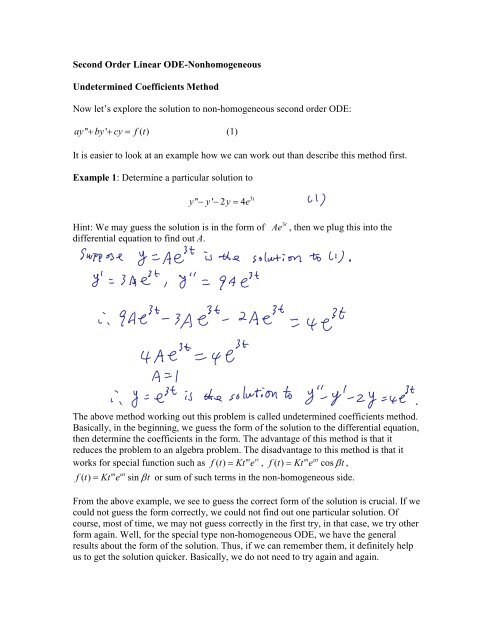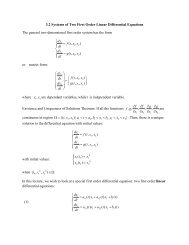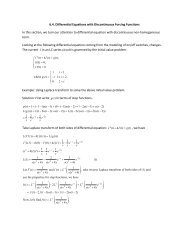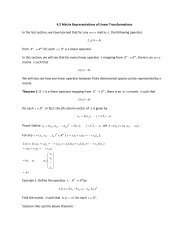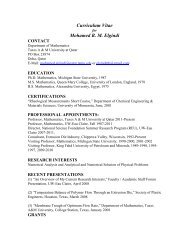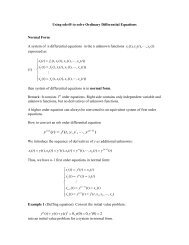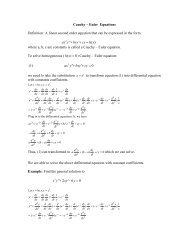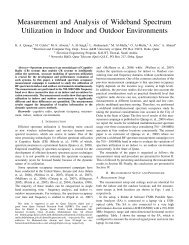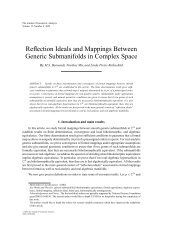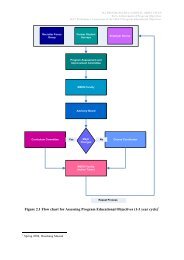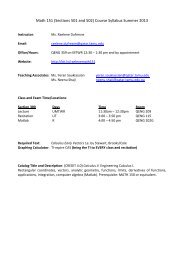Second Order Differential Equation III: Non-Homogeneous ...
Second Order Differential Equation III: Non-Homogeneous ...
Second Order Differential Equation III: Non-Homogeneous ...
You also want an ePaper? Increase the reach of your titles
YUMPU automatically turns print PDFs into web optimized ePapers that Google loves.
<strong>Second</strong> <strong>Order</strong> Linear ODE-<strong>Non</strong>homogeneousUndetermined Coefficients MethodNow let’s explore the solution to non-homogeneous second order ODE:ay '' + by ' + cy = f ( t)(1)It is easier to look at an example how we can work out than describe this method first.Example 1: Determine a particular solution toy − y − y = e3'' ' 2 4 tHint: We may guess the solution is in the form ofdifferential equation to find out A.3tAe , then we plug this into theThe above method working out this problem is called undetermined coefficients method.Basically, in the beginning, we guess the form of the solution to the differential equation,then determine the coefficients in the form. The advantage of this method is that itreduces the problem to an algebra problem. The disadvantage to this method is that itm rtm αtworks for special function such as f () t = Kt e , f () t = Kt e cosβt,() m αtf t = Kt e sinβtor sum of such terms in the non-homogeneous side.From the above example, we see to guess the correct form of the solution is crucial. If wecould not guess the form correctly, we could not find out one particular solution. Ofcourse, most of time, we may not guess correctly in the first try, in that case, we try otherform again. Well, for the special type non-homogeneous ODE, we have the generalresults about the form of the solution. Thus, if we can remember them, it definitely helpus to get the solution quicker. Basically, we do not need to try again and again.
Method of Undetermined Coefficientsm rtFor ay '' + by ' + cy = Kt e , the particular solution formy () t = t ( A t + L + At+A ) eps m rtm1 0with2a. s=0 if r is not a root of the associated characteristic equation ( ar + br + c = 0 );b. s=1 if r is a simple root of the associated characteristic equation;c. s=2 if r is a double root of the associated characteristic equation.m αtm αtFor ay '' + by ' + cy = Kt e sin βtor ay '' + by ' + cy = Kt e cos βt, the particular solutionformwithy () t = t ( A t + L+ At+A ) e cosβtps m αtm1 0+ t ( B t + L+ Bt+B ) e sinβts m αtm1 0a. s=0 if isα+ iβnot a root of the associated characteristic equation;b. s=1 if α + iβis a simple root of the associated characteristic equation;Example 2: Find out the form of the solution of the following differential equationwithout solving them:−ta. y'' + 2y'+y = te2 −b. y''+ 2y'+ 2y= t et sin tc.y'' + 2y'−3y= te−t
Example 3: Find out a particular solution of the following differential equationy' ' − 4y'+ 4y= 2tet


